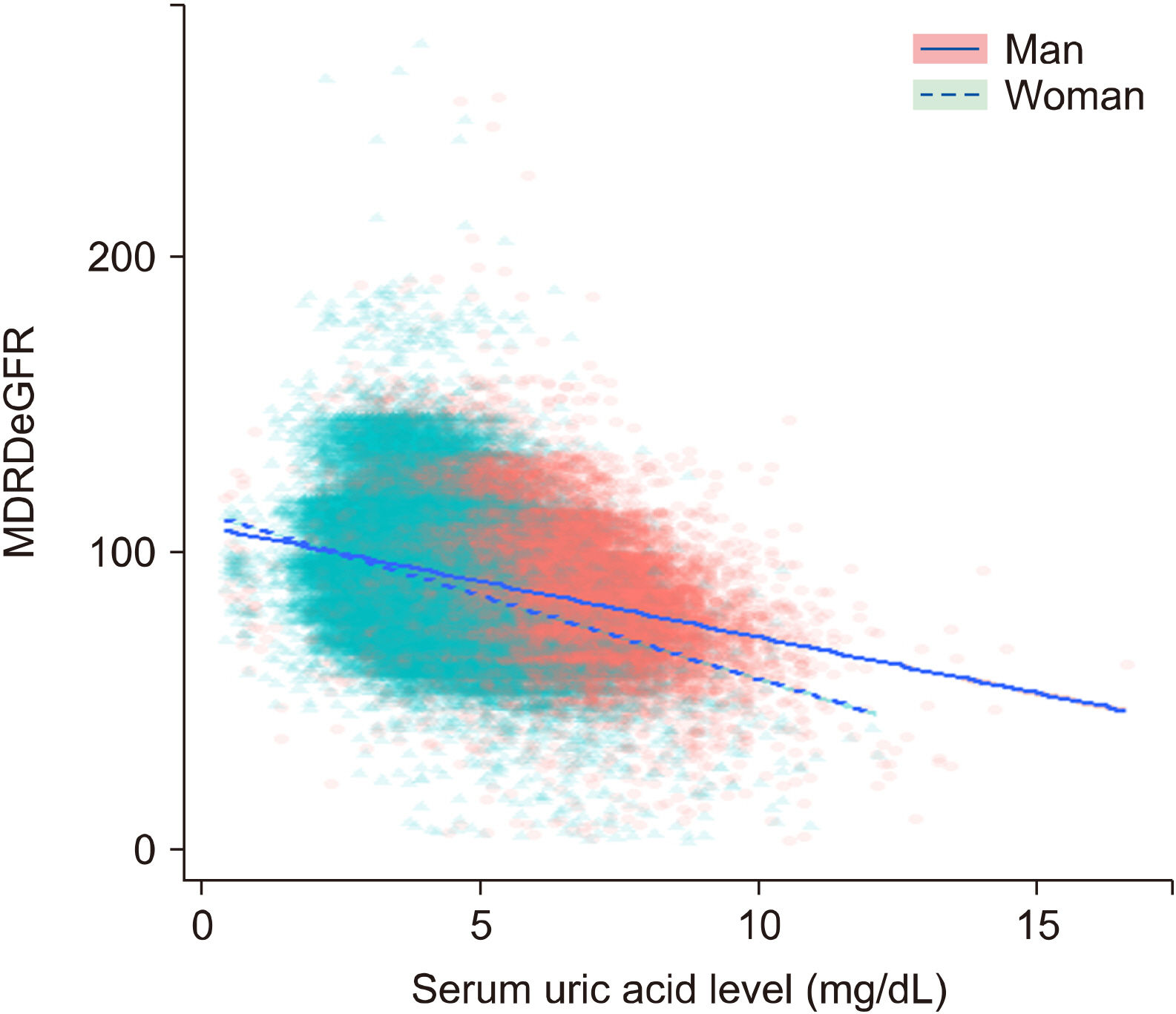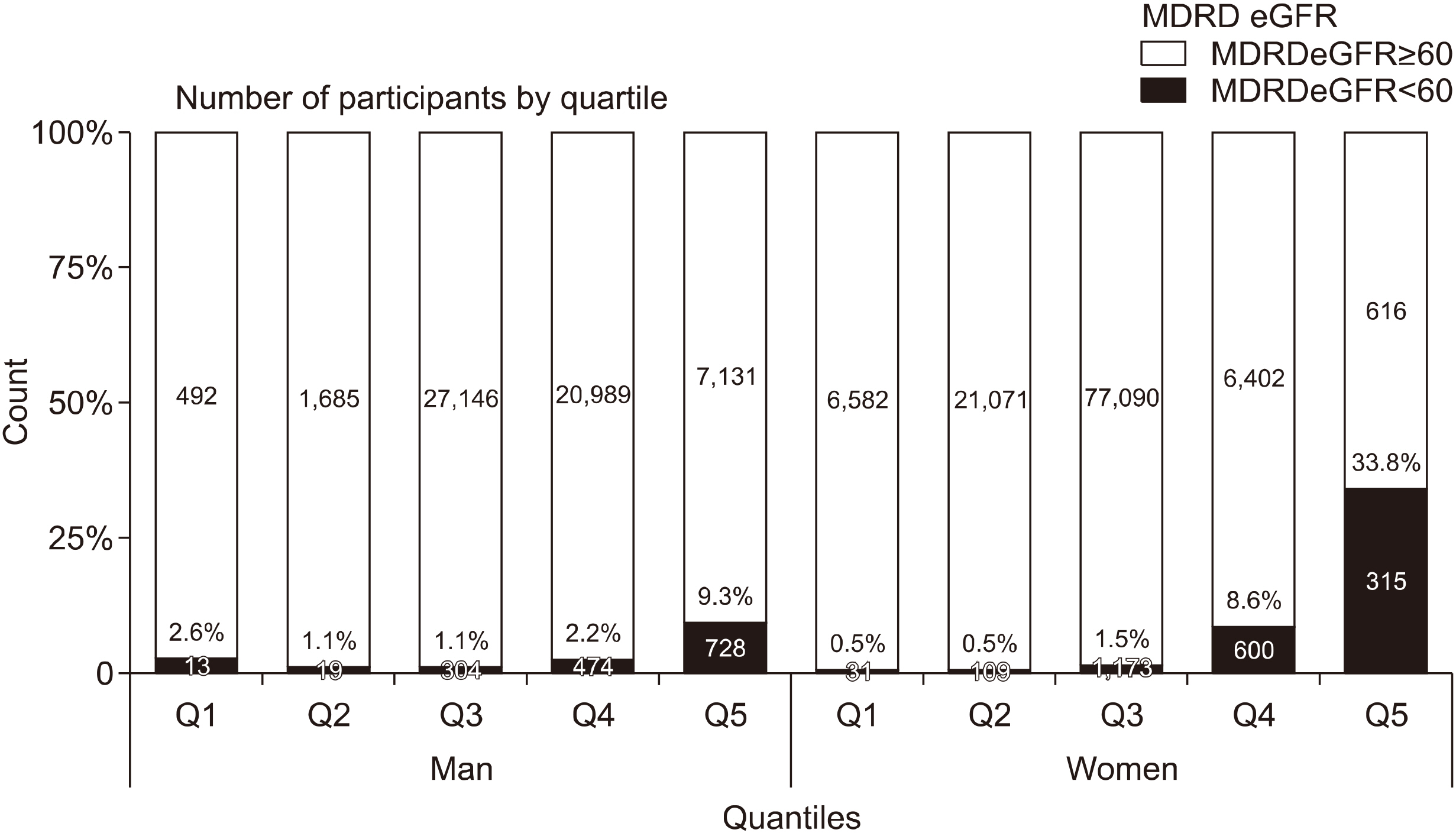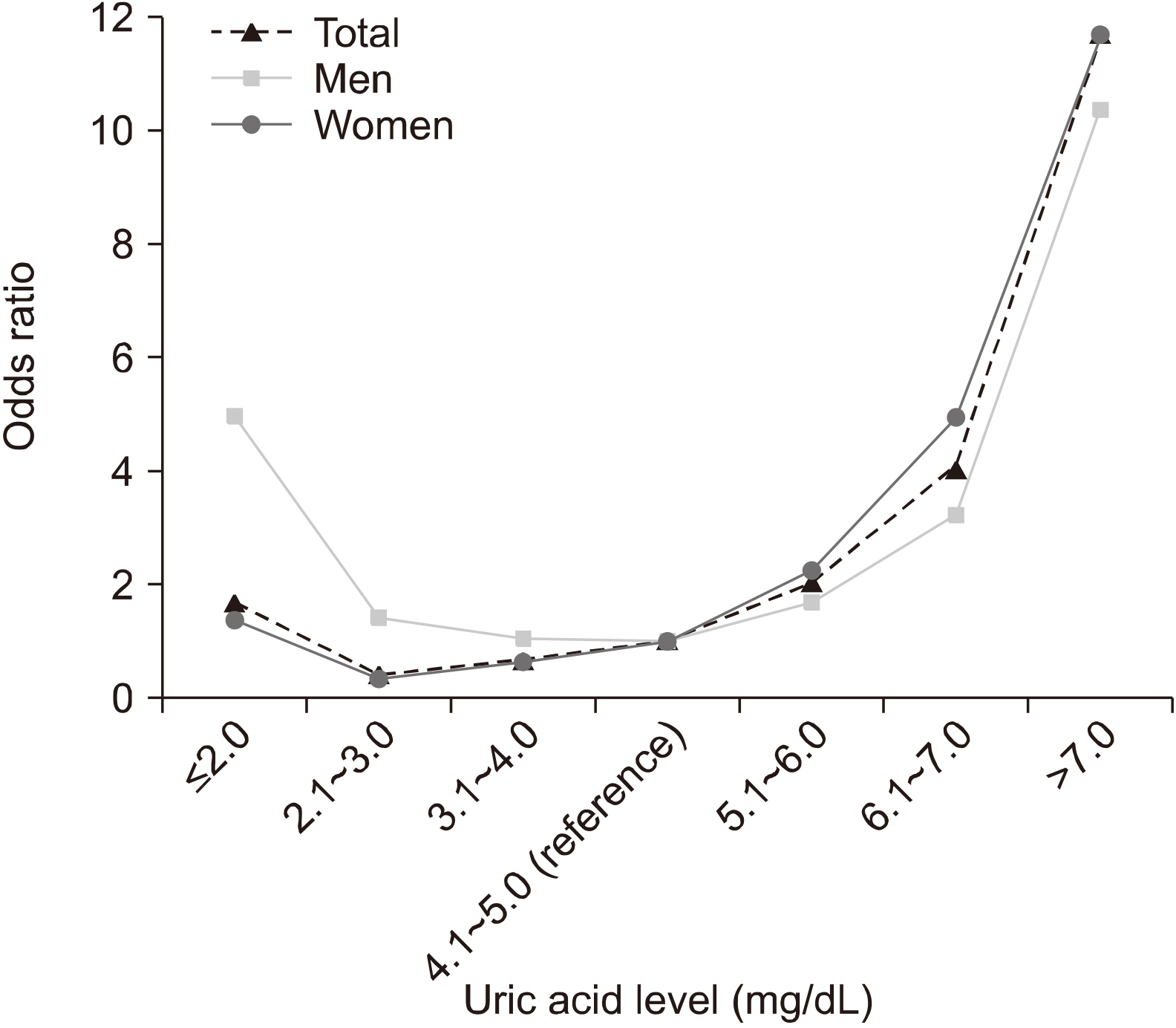J Rheum Dis.
2021 Oct;28(4):225-233. 10.4078/jrd.2021.28.4.225.
J-shaped Relationship Between Chronic Kidney Disease and Serum Uric Acid Levels: A Cross-sectional Study on the Korean Population
- Affiliations
-
- 1Department of Internal Medicine, Inje University Seoul Paik Hospital, Inje University College of Medicine, Seoul, Korea
- 2Department of Rheumatology, Keimyung University Dongsan Medical Center, Daegu, Korea
- 3Department of Internal Medicine, Hanyang University College of Medicine, Seoul, Korea
- 4Department of Rheumatology, Hanyang University Hospital for Rheumatic Diseases, Seoul, Korea
- KMID: 2520435
- DOI: http://doi.org/10.4078/jrd.2021.28.4.225
Abstract
Objective
Both hypouricemia and hyperuricemia are reportedly associated with reduced kidney function. This study investigated the association between uric acid levels and the risk of reduced renal function in men and women.
Methods
We conducted a cross-sectional study using data from a government-funded health examinee cohort of a Korean genome and epidemiological study. A total of 172,970 participants (58,981 men, 113,989 women) aged 40∼79 years were included. A logistic regression test was performed, and the odds ratio (OR) and 95% confidence interval (CI) were calculated to examine the relationship between stratified uric acid levels and the frequency of chronic kidney disease.
Results
As the uric acid level increased, the risk of reduced renal function increased. Moreover, for uric acid levels ≤2.0 mg/dL, the risk of reduced renal function was higher than that of the reference group. Among the total, man, and woman groups, a statistically significant association was observed in men (OR 1.71, 95% CI 0.945∼3.111, OR 5.003, 95% CI 1.405∼17.809, and OR 1.377, 95% CI 0.696∼2.724, respectively).
Conclusion
The OR of reduced renal function according to uric acid levels formed a J-shaped curve in both genders.
Keyword
Figure
Reference
-
1. Rock KL, Kataoka H, Lai JJ. 2013; Uric acid as a danger signal in gout and its comorbidities. Nat Rev Rheumatol. 9:13–23. DOI: 10.1038/nrrheum.2012.143. PMID: 22945591. PMCID: PMC3648987.
Article2. Singh JA. 2013; Racial and gender disparities among patients with gout. Curr Rheumatol Rep. 15:307. DOI: 10.1007/s11926-012-0307-x. PMID: 23315156. PMCID: PMC3545402.
Article3. Singh JA, Gaffo A. 2020; Gout epidemiology and comorbidities. Semin Arthritis Rheum. 50(3S):S11–6. DOI: 10.1016/j.semarthrit.2020.04.008. PMID: 32620196.
Article4. Maesaka JK, Fishbane S. 1998; Regulation of renal urate excretion: a critical review. Am J Kidney Dis. 32:917–33. DOI: 10.1016/S0272-6386(98)70067-8. PMID: 9856507.
Article5. Roch-Ramel F, Guisan B. 1999; Renal transport of urate in humans. News Physiol Sci. 14:80–4. DOI: 10.1152/physiologyonline.1999.14.2.80. PMID: 11390825.
Article6. Sharaf El Din UAA, Salem MM, Abdulazim DO. 2017; Uric acid in the pathogenesis of metabolic, renal, and cardiovascular diseases: a review. J Adv Res. 8:537–48. DOI: 10.1016/j.jare.2016.11.004. PMID: 28748119. PMCID: PMC5512153.
Article7. Kanda E, Muneyuki T, Kanno Y, Suwa K, Nakajima K. 2015; Uric acid level has a U-shaped association with loss of kidney function in healthy people: a prospective cohort study. PLoS One. 10:e0118031. DOI: 10.1371/journal.pone.0118031. PMID: 25658588. PMCID: PMC4320097.
Article8. Wang S, Shu Z, Tao Q, Yu C, Zhan S, Li L. 2011; Uric acid and incident chronic kidney disease in a large health check-up population in Taiwan. Nephrology (Carlton). 16:767–76. DOI: 10.1111/j.1440-1797.2011.01513.x. PMID: 21854506.
Article9. Park JH, Jo YI, Lee JH. 2020; Renal effects of uric acid: hyperuricemia and hypouricemia. Korean J Intern Med. 35:1291–304. DOI: 10.3904/kjim.2020.410. PMID: 32872730. PMCID: PMC7652664.
Article10. Wakasugi M, Kazama JJ, Narita I, Konta T, Fujimoto S, Iseki K, et al. 2015; Association between hypouricemia and reduced kidney function: a cross-sectional population-based study in Japan. Am J Nephrol. 41:138–46. DOI: 10.1159/000381106. PMID: 25790961.
Article11. Kim K, Go S, Son HE, Ryu JY, Lee H, Heo NJ, et al. 2020; Association between serum uric acid level and ESRD or death in a Korean population. J Korean Med Sci. 35:e254. DOI: 10.3346/jkms.2020.35.e254. PMID: 32686371. PMCID: PMC7371451.
Article12. Kim Y, Han BG. KoGES group. 2017; Cohort profile: The Korean Genome and Epidemiology Study (KoGES) consortium. Int J Epidemiol. 46:1350. DOI: 10.1093/ije/dyx105. PMID: 28938752. PMCID: PMC5837323.
Article13. Koo BS, Jeong HJ, Son CN, Kim SH, Kim HJ, Kim GH, et al. 2021; Distribution of serum uric acid levels and prevalence of hyper- and hypouricemia in a Korean general population of 172,970. Korean J Intern Med. 36(Suppl 1):S264–72. DOI: 10.3904/kjim.2020.116. PMID: 33227843. PMCID: PMC8009145.
Article14. Levey AS, Bosch JP, Lewis JB, Greene T, Rogers N, Roth D. 1999; A more accurate method to estimate glomerular filtration rate from serum creatinine: a new prediction equation. Modification of Diet in Renal Disease Study Group. Ann Intern Med. 130:461–70. DOI: 10.7326/0003-4819-130-6-199903160-00002. PMID: 10075613.15. Levey AS, Greene T, Kusek JW, Beck GJ. 2000; A simplified equation to predict glomerular filtration rate from serum creatinine. J Am Soc Nephrol. 11:155A.16. Iseki K, Ikemiya Y, Inoue T, Iseki C, Kinjo K, Takishita S. 2004; Significance of hyperuricemia as a risk factor for developing ESRD in a screened cohort. Am J Kidney Dis. 44:642–50. DOI: 10.1016/S0272-6386(04)00934-5. PMID: 15384015.
Article17. Obermayr RP, Temml C, Gutjahr G, Knechtelsdorfer M, Oberbauer R, Klauser-Braun R. 2008; Elevated uric acid increases the risk for kidney disease. J Am Soc Nephrol. 19:2407–13. DOI: 10.1681/ASN.2008010080. PMID: 18799720. PMCID: PMC2588108.
Article18. Park JT, Kim DK, Chang TI, Kim HW, Chang JH, Park SY, et al. 2009; Uric acid is associated with the rate of residual renal function decline in peritoneal dialysis patients. Nephrol Dial Transplant. 24:3520–5. DOI: 10.1093/ndt/gfp272. PMID: 19491381.
Article19. Kuo CF, Luo SF, See LC, Ko YS, Chen YM, Hwang JS, et al. 2011; Hyperuricaemia and accelerated reduction in renal function. Scand J Rheumatol. 40:116–21. DOI: 10.3109/03009742.2010.507218. PMID: 20868309.
Article20. Sedaghat S, Hoorn EJ, van Rooij FJ, Hofman A, Franco OH, Witteman JC, et al. 2013; Serum uric acid and chronic kidney disease: the role of hypertension. PLoS One. 8:e76827. DOI: 10.1371/journal.pone.0076827. PMID: 24265674. PMCID: PMC3827035.
Article21. Khosla UM, Zharikov S, Finch JL, Nakagawa T, Roncal C, Mu W, et al. 2005; Hyperuricemia induces endothelial dysfunction. Kidney Int. 67:1739–42. DOI: 10.1111/j.1523-1755.2005.00273.x. PMID: 15840020.
Article22. Hong Q, Qi K, Feng Z, Huang Z, Cui S, Wang L, et al. 2012; Hyperuricemia induces endothelial dysfunction via mitochondrial Na+/Ca2+ exchanger-mediated mitochondrial calcium overload. Cell Calcium. 51:402–10. DOI: 10.1016/j.ceca.2012.01.003. PMID: 22361139.23. Esparza Martín N, García Nieto V. 2011; Hypouricemia and tubular transport of uric acid. Nefrologia. 31:44–50. DOI: 10.3265/Nefrologia.pre2010.Oct.10588. PMID: 21270912.24. Suliman ME, Johnson RJ, García-López E, Qureshi AR, Molinaei H, Carrero JJ, et al. 2006; J-shaped mortality relationship for uric acid in CKD. Am J Kidney Dis. 48:761–71. DOI: 10.1053/j.ajkd.2006.08.019. PMID: 17059995.
Article25. Uedono H, Tsuda A, Ishimura E, Nakatani S, Kurajoh M, Mori K, et al. 2017; U-shaped relationship between serum uric acid levels and intrarenal hemodynamic parameters in healthy subjects. Am J Physiol Renal Physiol. 312:F992–7. DOI: 10.1152/ajprenal.00645.2016. PMID: 28249837.
Article26. Hirasaki S, Koide N, Fujita K, Ogawa H, Tsuji T. 1997; Two cases of renal hypouricemia with nephrolithiasis. Intern Med. 36:201–5. DOI: 10.2169/internalmedicine.36.201. PMID: 9144014.
Article27. Ohta T, Sakano T, Ogawa T, Kato J, Awaya Y, Kihara H, et al. 2002; Exercise-induced acute renal failure with renal hypouricemia: a case report and a review of the literature. Clin Nephrol. 58:313–6. DOI: 10.5414/CNP58313. PMID: 12400848.
Article28. Ohta T, Sakano T, Igarashi T, Itami N, Ogawa T. 2004; Exercise-induced acute renal failure associated with renal hypouricaemia: results of a questionnaire-based survey in Japan. Nephrol Dial Transplant. 19:1447–53. DOI: 10.1093/ndt/gfh094. PMID: 15150354.
Article29. Nakamura A, Niimi R, Yanagawa Y. 2006; Renal hypouricemia in school-aged children: screening of serum uric acid level before physical training. Pediatr Nephrol. 21:1898–900. DOI: 10.1007/s00467-006-0255-7. PMID: 16955280.
Article30. Kim YH, Cho JT. 2011; A case of exercise-induced acute renal failure with G774A mutation in SCL22A12 causing renal hypouricemia. J Korean Med Sci. 26:1238–40. DOI: 10.3346/jkms.2011.26.9.1238. PMID: 21935282. PMCID: PMC3172664.
Article31. Shen H, Feng C, Jin X, Mao J, Fu H, Gu W, et al. 2014; Recurrent exercise-induced acute kidney injury by idiopathic renal hypouricemia with a novel mutation in the SLC2A9 gene and literature review. BMC Pediatr. 14:73. DOI: 10.1186/1471-2431-14-73. PMID: 24628802. PMCID: PMC3984694.
Article32. Shichiri M, Iwamoto H, Marumo F. 1990; Diabetic hypouricemia as an indicator of clinical nephropathy. Am J Nephrol. 10:115–22. DOI: 10.1159/000168065. PMID: 2190467.
Article33. Mumford SL, Dasharathy SS, Pollack AZ, Perkins NJ, Mattison DR, Cole SR, et al. 2013; Serum uric acid in relation to endogenous reproductive hormones during the menstrual cycle: findings from the BioCycle study. Hum Reprod. 28:1853–62. DOI: 10.1093/humrep/det085. PMID: 23562957. PMCID: PMC3685334.
Article34. Wingrove CS, Walton C, Stevenson JC. 1998; The effect of menopause on serum uric acid levels in non-obese healthy women. Metabolism. 47:435–8. DOI: 10.1016/S0026-0495(98)90056-7. PMID: 9550542.
Article35. Hsu YH, Pai HC, Chang YM, Liu WH, Hsu CC. 2013; Alcohol consumption is inversely associated with stage 3 chronic kidney disease in middle-aged Taiwanese men. BMC Nephrol. 14:254. DOI: 10.1186/1471-2369-14-254. PMID: 24238625. PMCID: PMC3840676.
Article36. Schaeffner ES, Kurth T, de Jong PE, Glynn RJ, Buring JE, Gaziano JM. 2005; Alcohol consumption and the risk of renal dysfunction in apparently healthy men. Arch Intern Med. 165:1048–53. DOI: 10.1001/archinte.165.9.1048. PMID: 15883245.
Article37. Park M, Lee SM, Yoon HJ. 2019; Association between alcohol intake and measures of incident CKD: an analysis of nationwide health screening data. PLoS One. 14:e0222123. DOI: 10.1371/journal.pone.0222123. PMID: 31539384. PMCID: PMC6754126.
Article
- Full Text Links
- Actions
-
Cited
- CITED
-
- Close
- Share
- Similar articles
-
- Association between serum uric acid and kidney disease with pediatric focus
- Associations of Coffee Consumption and Serum Uric Acid Levels in Korean Adults: Korea National Health and Nutrition Examination Survey, 2016
- Relationship of Serum Uric Acid to Cardiovascular Risk Factors in Korean Male Workers
- Observation of the Serum Uric Acid in Essential Hypertension
- Serum Uric Acid Levels In Korean Adult Population And Their Correlates





